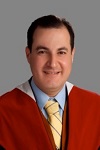Day 20 :
- Track 2 : Microbes: Fermentation Processes
Track 3: Microbes: Food and Agriculture
Track 6 : Parameter of Microbial Growth

Co-Chair
Zhigang (Peter) Zhou
Chinese Academy of Agricultural Sciences, China
Session Introduction
Alexander Sulakvelidze
Intralytix, USA
Title: Bacteriophages - new class of beneficial microbes and their practical applications

Biography:
Dr. Alexander Sulakvelidze, Ph.D. is Chief Scientist of Intralytix, and an internationally recognized expert in phage technology. Dr. Sulakvelidze has published extensively on the subject of phage therapy, including co-editing a major book about bacteriophages in 2005. He is the author of several issued and pending patents in the field of phage therapy. Dr. Sulakvelidze is currently serving as Editor-in-Chief of the journal Bacteriophage, and as an ad hoc reviewer for several other journals and funding agencies.
Abstract:
Probiotics offer the promise of health benefits by altering the commensal gut microbiota, and they continue to gain in popularity. However, one approach for a “probiotic intervention” that has not received much prior attention is to use lytic bacteriophages (or phages) to target specific pathogenic bacteria in the gastrointestinal (GI) tract, oral cavity, skin, etc. before they can cause disease. Lytic phages are bacterial viruses that attach to and kill their bacterial hosts by lysing them during their internal replication cycle. Bacteriophages are arguably the oldest (ca. 3.5 billion-years-old) and most ubiquitous organisms (1030-1032 phage particles) on Earth, and they have remarkable bactericidal activity against their specific bacterial hosts; i.e., phages attack their targeted bacterial hosts but cannot infect human or other eukaryotic cells. The approach of using lytic phages as part of a probiotic diet is similar to that used for bacteria-based probiotics, which are administered during a period of time and act by favorably conditioning the gut, mouth, skin, etc. microflora. The key difference between bacteria-based probiotics and lytic phage-based probiotics (designated “phage-biotics”) is that the former introduce nonpathogenic bacteria into the mammalian organism (in order to interfere with the ability of pathogenic bacteria to colonize and cause disease); whereas, the latter use lytic phage to kill specific pathogenic bacteria. Thus, bacteriophages represent a new class of beneficial microbes that may have a wide-range of practical applications in human and veterinary medicine, food safety, cosmetics, and other areas. The presentation will give the audience a current perspective about the history of bacteriophage therapy research and the crucial regulatory and human safety issues concerning the use of bacteriophages as phage-biotics. Phage-based probiotics are expected to have, because of their high specific activity, a very gentle effect on the overall microflora, which may further enhance their protective effects. They are also expected to be compatible – and, in fact, synergistic – with all classical bacteria-based probiotics. Thus, the phage-based probiotic approach may serve as a platform technology for developing a new class of super-probiotics for managing bacterial infections. Moreover, phage-biotics may be valuable tools for advancing our understanding of the important physiological roles that some normal flora bacteria have in the mammalian organism. That knowledge may help to identify new strategies for improving human health in areas not involving the prevention and treatment of bacterial diseases; e.g., reducing the occurrence of obesity and some forms of cancer, where the GI tract’s normal microbiota may have a role.

Biography:
Joelle Woolston is a research scientist and laboratory manager at Intralytix, where she provides hands-on research, directs and supervises laboratory staff, and assists in the regulatory approval process. Prior to joining Intralytix, she worked on metabolic transporters at the Childrens’ Hospital in Washington, D.C. and co-developed a patented phage-based vector system at the University of Maryland.
Abstract:
The use of bacteriophages as biocontrol agents is an environmentally friendly, all-natural method to eliminate or significantly reduce contamination of food by pathogenic bacteria. Bacteriophages, arguably the oldest and most ubiquitous organisms on Earth, are viruses that kill bacteria. They play a key role in maintaining the microbial balance in any ecosystem where bacteria exist and are part of the normal microflora of all fresh, unprocessed foods. Interest in bacteriophages has been gaining momentum in recent years, as reflected in the both the number of regulatory approvals for bacteriophage products and the number of published studies. Because of the specificity of bacteriophages, their application only affects the target bacteria (the pathogen) but will not affect the other naturally present and potentially beneficial microflora. Bacteriophage products that target Listeria monocytogenes, Salmonella, and E. coli have been shown to reduce or completely eliminate the specific pathogen on a variety of foods, including beef, chicken, seafood, fruits and vegetables, and dairy products. In the US, several have been cleared as GRAS, with others receiving FCN and FAP approvals. Furthermore, none of the phage preparations affect the treated foods’ flavors, aromas, or appearances. The presentation will review information about the use of bacteriophages in foods and food processing settings, as well as discuss regulatory and safety issues concerning the use of bacteriophages in the food industry
Andrey Aleshkin
Gabrichevsky Moscow Research Institute for Epidemiology and Microbiology, Russia
Title: Phagebiotics in treatment and prophylaxis of foodborne infections

Biography:
Andrey Aleshkin, Sc.D.-biology, now is head of the Laboratory for Clinical Microbiology and Biotechnology of Bacteriophages of Gabrichevsky Moscow Research Institute of Epidemiology and Microbiology (MRIEM) and chief scientist in Bphage LLC. He received his Ph.D.-medicine in medical cybernetics at Pirogov Russian National Medical University, MBA in marketing at Lomonosov Moscow State University, Sc.D. in biotechnology and microbiology at Gabrichevsky MRIEM. Currently Dr. Andrey Aleshkin’s research focuses on the clinical safety and specific activity of bacteriophages as probiotics and decontaminating agents for food products. He has published more than 60 papers in peer-reviewed journals and 30 patents in Russia.
Abstract:
The more prevalent bacterial strains increasing in numbers are those with high thermostability, resistant to many present-day antibiotics and disinfectants, those which are capable to cause foodborne infections (FBI) with high mortality incidence among patients. In this situation using the accumulated Russian experience it is logical to propose a worldwide development of a renewed class of antibacterial agents based on bacteriophages. Since 1930s in different parts of the Soviet Union a lot of doctors began to use phages in human prophylaxis and therapy. Later in the 1960s four Institutes for Vaccines and Sera (in Ufa, Tbilisi, Nizhnii Novgorod, and Perm’) began to produce a dozen medicinal compounds based on several individual species of bacteriophages or their combinations which were used to treat and prevent acute intestinal infections and decompensated forms of dysbacteriosis and to control causative agents of certain pyoinflammatory infections. In recent years in the Russian Federation phage cocktails are administered intracorporeally or locally: wound and mucosa irrigation, introduction in the cavities of vagina, urinary bladder, ear, paranasal sinus, eye conjuctiva and also in the drained cavities: abdominal, and pleural, in the cavities of abscesses after the pus was removed. Therefore, world scientists should not neglect these clinical results when designing any future studies. We have developed a phagebiotic for prophylaxis of FBI caused by E.coli, Shigella flexneri, Shigella sonnei, Salmonella enterica, Listeria monocytogenes or Staphylococcus aureus, and investigated its effectiveness against infection caused by the non-pathogenic Lac (-) strain of E.coli in animal and human trials
Lawrence Goodridge
McGill University, Montreal, Quebec, Canada
Title: Reprogramming the gut: Bacteriophages and their roles in modifying the gastrointestinal microflora

Biography:
Dr. Lawrence Goodridge is a native of Hamilton, Ontario, Canada, and received his Ph.D. from the University of Guelph (pronounced Gwelf) in Guelph, Ontario, Canada with a major emphasis in Food Microbiology and Food Safety in 2002. Currently, Dr. Goodridge is the Ian and Jayne Munro Chair in Food Safety at McGill University. Dr. Goodridge’s primary research interest is the use of bacteriophages to study and solve problems associated with the production of food. He has published more than 55 peer reviewed publications and book chapters on topics related to food safety.
Abstract:
While it has long been understood that microorganisms in the human gut play an important role in digestive health, more recent research indicates that gut bacteria may relate to wider aspects of health, including obesity and metabolic health. The role that bacteriophages play in modulating the gut microflora and potentially the systemic health of animals (including humans) is increasing being recongized. The animal gastrointestinal tract (GIT) contains 1015 bacteriophages, which are collectively referred to as the phageome. Individual phageomes vary depending on age and health, thus providing a useful biomarker of animal health as well as suggesting potential interventions that could be targeted at the gut microbiota. Additionally, recent research has shed light on the how the phageome actively modulates the microflora as well as the survival, and thus efficacy of probiotic bacteria within the animal GIT. For example, phages that are unique to individual bacterial isolates have been shown to act as a predator, infecting and killing similar, competing bacterial strains, providing a competitive advantage to the bacteria harbouring the phage, by decreasing competition for available nutirents in the GIT. In this way, phages are expected to have a significant role in driving the biodiversity of the complex ecosystem of the animal GIT. Further exploration is neccesary in order to harness the enormous potential of the phageome to reprogram the microflora of the GIT, either to prevent diseases from occurring or in response to an active disease.
Alejandro Pérez-de-Luque
University of Sheffield, United kingdom
Title: Belowground interactions between mycorrhiza and rhizobacteria prime above ground wheat defence

Biography:
Alejandro Pérez-de-Luque is a plant researcher and agronomist, interested in resistance of plants against phytopathogens (parasitic plants, fungi, etc.). He started his career back in 1994, during the universitary studies, as undergraduate assistant in the Department of Biochemistry and Molecular Biology at the University of Córdoba (Spain). After getting the degree in Agronomical Engineering, he received a grant for PhD studies in the Department of Genetic at the University of Córdoba. He has been working in different institutes and researching centers in Spain, UK and Israel, and has been awarded contracts from the \\\\\\\'Juan de la Cierva\\\\\\\' and \\\\\\\'Ramon y Cajal\\\\\\\' Spanish post-doc programmes. He is a permanent researcher in the Department of Plant Breeding and Biotechnology at the IFAPA since 2009, and he held a two years Marie Curie Intra-European Fellowship at the University of Sheffield
Abstract:
Plant breeding for resistance genes and chemical treatments are currently the main strategies to control plant diseases. However, withdrawal of agrochemicals under new EU legislation and co--â€evolution of diseases to overcome crop resistance genes have increased the need to find alternative means to improve crop disease management. Disease suppression by root colonizing non--â€pathogenic microorganisms has been Recognized as a promising long--â€term strategy. Beneficial rhizosphere--â€colonizing microorganisms, such as arbuscular mycorrhiza fungi (AMF) and plant growth--â€promoting rhizobacteria (PGPR), can prime the plant immune system against pathogen attack (Cameron et al., 2013). However, the complexity of the plant root microbiome has hampered wide--â€ranging exploitation of these biocontrol organisms in current crop protection schemes. In this work, we have evaluated the interaction between two beneficial microorganisms, a mycorrhizal fungus (Glomus intraradices) and a plant growth promoting rhizobacterial strain (Pseudomonas putida) and investigated the mechanisms by which these microbes synergistically prime wheat (Triticum aestivum) for enhanced defensive responses.
Stéphane Duboux
Nestlé Research Center, Lausanne, Switzerland
Title: The Key to Acetate: Metabolic Fluxes of Acetic Acid Bacteria under Cocoa Pulp Fermentation-Simulation Conditions
Biography:
Stéphane Duboux is currently working in Nestlé Research Center, Lausanne, Switzerland. He has published various papers in various journals
Abstract:
Chocolate preprocessing involves pod opening, bean (pulp) fermentation, and bean drying, followed by roasting of the cocoa beans (1). Cocoa bean fermentation is a spontaneous process that is carried out under rather uncontrolled conditions. Thus, the result of the fermentation process strongly depends on the microbial population of the pulp and postharvest practices on the farm (2). Acetic acid bacteria (AAB) play an important role during cocoa fermentation, as their main product, acetate, is a major driver for the development of the desired cocoa flavors (3, 4). Here, we investigated the specialized metabolism of these bacteria under cocoa pulp fermentation-simulating conditions via carefully designed combination of parallel 13C isotope labeling experiments. The received insights supported the first development of experimental starter cultures.
Marta Dudkiewicz
Lodz University of Technology, Poland
Title: Amino-acid profiles of Yeast Autolysates
Biography:
Marta Dudkiewicz has graduated from Lodz University of Technology (LUT) with BSc in Technical Microbiology and MSc in Fermentation Technology. The subject of her MSc thesis, which she completed in 2014, was “The utilization of sugar beet pulp hydrolysate for lactic acid fermentation”. Currently, she is employed by Institute of Fermentation Technology and Microbiology (LUT), working as a scientist and researcher and doing research for Applied Research Programme – Project PBS1/B8/3/2012. She is a co-author of several articles which are going to be published soon.
Abstract:
The interest in the production of yeast extracts and their use as food additives has been growing in the recent years. Yeast extracts can be obtained from pure culture or from post – fermentation cultures. Free amino acids in the extracts are known to have a major influence on flavor. Yeast hydrolysates with higher concentrations of valine, leucine, threonine and phenylalanine, as well as of sulfur amino acids (cysteine and methionine), could enhance flavor. This work presents the results of a study to determine the effect of Quillaja saponaria saponins on the autolysis of industrial yeast strains. Saponin is a relatively unconventional inductor for yeast autolysis. Cells treated with saponin retain sufficient integrity for rapid equilibration. The proposed method also has the advantages of relatively low cost, low added salt and well-documented health benefits. The distillery yeasts (Saccharomyces cerevisiae (Lesaffre) and Kluyveromyces marxianus LOCK0026) were used as pure cultures in the study, as well as post-fermentation mixed cultures. Cell suspension density was estimated using a Muse® Cell Analyzer. The concentration of proteins was measured using Direct Detect® system. Free amino nitrogen concentration (FAN) was determined based on the colour reaction with ninhydrin. The concentration of ammonia nitrogen was measured colorimetrically with Nessler’s reagent. Free amino acids in the autolysates was measured using the Pico-Tag method. The presence of saponin during autolysis resulted in a substantial increase in the concentration of nitrogen compounds, in comparison to tests without this agent. Post-fermentation biomass had more interesting amino – acid profile than aerobically propagated monocultures.
Marina Donova
Russian Academy of Sciences, Russia
Title: Phytosterol Bioconversions by Actinobacteria and Their Application in Steroid Pharmaceutical Industry

Biography:
Marina Donova has completed her PhD at 1992, and has got a degree of Doctor of Sciences (Biology) in 2006 at the Institute of Biochemistry and Physiology of Microorganisms, Russian Academy of Sciences (IBPM RAS). Since 1998, she is a Head of Laboratory MTOC at IBPM RAS. The interests of Dr. Donova cover all aspects of steroid conversions by microorganisms including discovery of novel biocatalysts, investigation of metabolic pathways, the development and scaling up of the biotechnologies. The competence and qualification of Dr.Donova is confirmed by over 70 peer reviewed papers, one monograph and over 10 RF patents.
Abstract:
Phytosterols represent available and low-cost raw materials for steroid pharmaceutical industry. Bioconversion of phytosterols using selected wild-type and recombinant strains of actinobacteria is an effective way to produce high-valued steroidal drugs and their precursors. Although considerable progress was achieved during last decade in the development of biotechnologies for production of key intermediates from phytosterol, the important task is selection of suitable microorganisms, as well as creation of engineered strains to provide improved bioprocesses and to generate novel products. Recently, whole genome sequencing of several sterol-transforming actinobacteria strains was carried out and the phytosterol catabolism associated genes were revealed related to steroid import across the cell wall, side-chain degradation and steroid core degradation, as well as to other key steroid modifications. The features of the genomes clarified the capability of the strains to accumulate different androstanes as major products from phytosterol. The transcriptomic studies provided more clear understanding of the role of candidate genes in steroid modifications by the strains. The significance of the findings for creating of effective microbial catalysts for phytosterol conversion is highlighted. The novel data on the production methods of androstenedione (AD), 1-dehydro-AD (ADD), 9α-hydroxy-AD, 11α-hydroxy-AD, 9(11)-dehydro-AD, dehydroepiandrosterone, testosterone, 1-dehydrotestosterone, as well as progesterone and 20-hydroxymethylpregnanes from phytosterol using selected and engineered actinobacteria are presented. The challenges and prospects of phytosterol conversion by actinobacteria are discussed.
Françoise Leroi
Ifremer, France
Title: Use of bioprotective bacteria to guaranty quality and safety of seafood products

Biography:
Dr Françoise Leroi is the head of the laboratory Microbial Ecosystems and Marine Molecules for Biotechnology (EM3B) at Ifremer (Nantes, France). Since 1994, she has been working on quality and safety of seafood products, microbial ecology, identification of spoiling microorganisms, microbial growth modelling and impact of processes. She has been working on biopreservation of seafood for more than 20 years. She is member of the National Technological Network on Bioprotective Cultures created in France in 2009. She is project leader of many national and European projects. She has published more than 45 papers in reputed journals and has been serving as an editorial board member of the Journal of Aquatic Food Product Technology.
Abstract:
Around 10 to 20% of all outbreaks are attributed to seafood. For indigenous bacteria (Clostridium botulinum, Vibrio spp., Aeromonas, Listeria monocytogenes, histamine-producing bacteria…), the hazard concern (i) fresh or lightly preserved products in which the growth of those bacteria is possible and which are eaten raw or insufficiently cooked ; (ii) Scombroid and Clupeid fish stored at abuse temperature ; (iii) shellfish which concentrate the bacteria and virus during their filter feeding. Other micro-organisms such as Salmonella, Shigella, Echerichia coli, Staphylococcus aureus… can be introduced in the aquatic environment or during post harvest handling and processing. Beside this short review, the biopreservation technology will be presented. Biopreservation is a method of preserving food using microorganisms, which are thus called protective cultures (PCs). This technology consists of inoculating a food with a non-pathogenic microorganism, selected to prevent the development of other undesirable microbes and thus guaranty its safety and quality. LAB are good candidates for biopreservation because (i) they have many natural antibacterial properties (ii) they are part of the common flora of many foods; (iii) they are recognized as non-hazardous to human health; (iv) they benefit from a healthy image conveyed to consumers by dairy products. This talk will present the strategy of protective culture selection, the mechanisms of action, the regulation context and examples of application in seafood, especially for prevention of risk associated to spoiling bacteria, histamine-producing bacteria and L. monocytogenes.
Imane Wahby
MAScIR, Morocco
Title: Microalgae for industrial applications: from laboratory to industry

Biography:
Imane Wahby has completed his PhD at the age of 28 years from Granada University and postdoctoral studies from CSIC. She is the director of Green Biotechnology Center in MAScIR (Morocco) working on the valorization of natural resources. She has 4 papers published and 8 patents related to the industrial application of microalgae. She led more than 10 projects for industrial application of microorganisms mainly in the field of agriculture, alimentation and cosmetic.
Abstract:
Microalgae represent an emerging biological resource of great importance for its potential applications in different fields, in particular as a new source of valuable nutrients and biologically active molecules. MAScIR works since 2010 on a global project for microalgae valorization and developed a microalgae collection fully characterized (lipids, FAMEs profile, proteins, biological activities, etc.). Four projects are ongoing to develop products for agriculture and ingredients for neutraceutic and cosmetic use. Indeed microalgae with high content of amino acids, nitrogen, phosphorus and phytohormons was used to formulate a liquid product used as biofertiliser/growth booster developed with an industrial partner operating in biological agriculture. Other microalgae, mainly belonging to Arthrospira and Isochrysis genius, showed highest polysaccharides content and are used to formulate anti-stress products for agriculture. Developed formula allowed plants growth in highly saline soil and increased plant immunity against some bacterial and fungal disease (Botrytis and Clavibacter). For neutraceutical application, some microalgae showed high content of PUFA, iron and proteins (70% DW) and are used to develop a new formula containing high PUFA content coupled with two active extracts, actually in pre-commercial phase. Development of pharmaceutical ingredients from microalgae for cosmetic application is also targeted, a newly developed formula showed an anti-acne activity combining: bacteriostatic effect against the two bacteria responsible of the acne: Propionibacterium acnes and Staphylococcus epidermidis, anti-inflammatory and antioxydant effect and skin cell regenerative effect for an integral treatment of the acne. The bridge between R&D and industrial scale will be discussed for each project.
Osama Sam Ibhrahim
Consultant Biotechnology/ Food safety Bio Innovation U.S.A
Title: Expression of shiga-like toxin fused to vascular endothelial growth factor in Escherichia .coli for target angiogenesis

Biography:
Dr. Osama Ibrahim is a highly-experienced Principal Research Scientist with particular expertise in the field of microbiology, molecular biology, food safety, and bioprocessing for both pharmaceutical and food ingredients. He is knowledgeable in microbial screening /culture improvement; molecular biology and fermentation research for antibiotics, enzymes, therapeutic proteins, organic acids and food flavors; Biochemistry for metabolic pathways and enzymes kinetics, enzymes immobilization, bioconversion, and Analytical Biochemistry. Dr. Ibrahim was external research liaison for Kraft Foods with Universities for research projects related to molecular biology and microbial screening and holds three bioprocessing patents. In January 2005, he accepted an early retirement offer from Kraft Foods and in the same year he formed his own biotechnology company providing technical and marketing consultation for new startup biotechnology and food companies. Dr. Ibrahim received his B.S. in Agricultural Biochemistry with honor and two M.S. degrees in Microbial physiology/ Fermentation and in Applied Microbiology. He received his Ph.D in Basic Medical Science (Microbiology, Immunology and Molecular biology) from New York Medical College. His research dissertation was on the construction of plasmid for the expression of a fusion protein of VEGF121/ Shiga-like toxin as a therapeutic protein for targeting angiogenesis. He is a member of American Chemical Society, American Society of Microbiology, and Society of Industrial Microbiology since 1979
Abstract:
Angiogenesis is a highly controlled process of growing new blood vessels. Under normal circumstances angiogenesis occurs only during embryonic development, wound healing and development of the corpus luteum. However, in a large number of pathologies, such as solid tumor growth, various eye diseases and chronic inflammation states, angiogenesis is a crucial component of the disease process. Therefore, inhibitors of angiogenesis are being investigated as potential therapeutics for these pathologies. During angiogenesis endothelial cells of existing blood vessels undergo a complex process of reshaping, migration, growth, and organizing into new vessels. Vascular endothelial growth factor (VEGF) is a central mediator of this process and acts via receptors whose expression is restricted almost exclusively to endothelial cells. Because of its selectivity, VEGF represents a unique vehicle for delivery of inhibitors of angiogenesis to endothelial cells. Among potential inhibitors of angiogenesis, the shiga-like toxin-1 (SLT-I) produced by E.coli O157:H7 has the advantage that endothelial cells appear to be particularly sensitive to its action. Combining an SLT-I toxin with VEGF as a delivery vehicle would serve as a highly selective and active inhibitor of angiogenesis. Plasmids encoding the fusion proteins VEGF121 /A1 containing the catalytically active fragment of the SLT-I A subunit and VEGF121/A containing the full length A subunit of SLT-I were constructed in pET-29a and pET-32a systems. Escherichia coli BL21 (DE3) pLysS bacteria were transformed with the plasmid constructs and expressed fusion proteins were recovered in inclusion bodies upon induction with isopropyl –B-D-thiogalactopyranoside (IPTG). Both purified fusion proteins inhibited the translation of luciferase mRNA as a reporter gene in vitro translation system, indicating that both fusion proteins retain the N-glycosidase activity of SLT-I. However, only VEGF121/A1 fusion proteins displayed the ability to induce auto-phosphorylation of the VEGF receptor KDR/FLK-1.. In a biological assay VEGF121/A1 fusion proteins displayed a strong, selective growth inhibition of cultured cells expressing KDR/FLK-1 receptors. In summary, these results indicate that VEGF/SLT fusion proteins are promising therapeutic agents that can be developed into powerful and selective inhibitors of angiogenesis.
Osama Sam Ibhrahim
Consultant Biotechnology/ Food safety Bio Innovation U.S.A
Title: The nature of prebiotics and the impact of prebiotics/probiotics on gut health

Biography:
Dr. Osama Ibrahim is a highly-experienced Principal Research Scientist with particular expertise in the field of microbiology, molecular biology, food safety, and bioprocessing for both pharmaceutical and food ingredients. He is knowledgeable in microbial screening /culture improvement; molecular biology and fermentation research for antibiotics, enzymes, therapeutic proteins, organic acids and food flavors; Biochemistry for metabolic pathways and enzymes kinetics, enzymes immobilization, bioconversion, and Analytical Biochemistry. Dr. Ibrahim was external research liaison for Kraft Foods with Universities for research projects related to molecular biology and microbial screening and holds three bioprocessing patents. In January 2005, he accepted an early retirement offer from Kraft Foods and in the same year he formed his own biotechnology company providing technical and marketing consultation for new startup biotechnology and food companies. Dr. Ibrahim received his B.S. in Agricultural Biochemistry with honor and two M.S. degrees in Microbial physiology/ Fermentation and in Applied Microbiology. He received his Ph.D in Basic Medical Science (Microbiology, Immunology and Molecular biology) from New York Medical College. His research dissertation was on the construction of plasmid for the expression of a fusion protein of VEGF121/ Shiga-like toxin as a therapeutic protein for targeting angiogenesis. He is a member of American Chemical Society, American Society of Microbiology, and Society of Industrial Microbiology since 1979
Abstract:
Prebiotics are the fermentable, non-digestible carbohydrates that stimulate as nutrients the growth and the activity of beneficial bacteria (probiotics) in the digestive system. There are two prebiotics categories: Prebiotics fibers that are naturally occurred in whole grain, broccoli, asparagus, radish, cabbage, etc, and Prebiotics oligosaccharides such as Fracto-oligosaccharide (FOX), Galacto-oligosaccharides (GOS), Xylo-oligisaccharides (XOS), polydextrine etc. These prebiotics oligosaccharides are increasingly added to foods for their health benefits and are not labeled as fibers in the United States. Prebiotics oligosaccharides are synthetically manufactured or extracted from plants in pure forms. Probiotics are the beneficial bacteria in the colon such as Befidobacteria and lactic acid bacteria. These probiotics bacteria assist in the maintenance of the natural balance of micro flora in the digestive system to reduce the effect of the harmful and pathogenic bacteria in the digestive system, suggesting that these probiotics bacteria can prevent gastrointestinal tract from infection diseases and reduce gut inflammation. It is also, assumed that probiotics bacteria strengthen the immune system. Synbiotics are products that contain both prebiotics and probiotics. These products have the non-digestible carbohydrates source (prebiotics) and the good bacteria (probiotics) Manufacturing of the major prebiotics oligosaccharides and the impact of synbiotics on gut health will be highlighted in this presentation.
Osama Sam Ibhrahim
Consultant Biotechnology/ Food safety,Bio Innovation, USA
Title: Microbial Fermentation (Enzymes, Metabolic pathways and Fermentation aspects)

Biography:
Dr. Osama Ibrahim is a highly-experienced Principal Research Scientist with particular expertise in the field of microbiology, molecular biology, food safety, and bioprocessing for both pharmaceutical and food ingredients. He is knowledgeable in microbial screening /culture improvement; molecular biology and fermentation research for antibiotics, enzymes, therapeutic proteins, organic acids and food flavors; Biochemistry for metabolic pathways and enzymes kinetics, enzymes immobilization, bioconversion, and Analytical Biochemistry. Dr. Ibrahim was external research liaison for Kraft Foods with Universities for research projects related to molecular biology and microbial screening and holds three bioprocessing patents. In January 2005, he accepted an early retirement offer from Kraft Foods and in the same year he formed his own biotechnology company providing technical and marketing consultation for new startup biotechnology and food companies. Dr. Ibrahim received his B.S. in Agricultural Biochemistry with honor and two M.S. degrees in Microbial physiology/ Fermentation and in Applied Microbiology. He received his Ph.D in Basic Medical Science (Microbiology, Immunology and Molecular biology) from New York Medical College. His research dissertation was on the construction of plasmid for the expression of a fusion protein of VEGF121/ Shiga-like toxin as a therapeutic protein for targeting angiogenesis. He is a member of American Chemical Society, American Society of Microbiology, and Society of Industrial Microbiology since 1979
Abstract:
The original definition of fermentation is the anaerobic conversion of sugars to ethanol and carbon dioxide by yeast. This original definition has been expanded over time to the conversion of organic materials by multiple diversities of organisms (bacteria, yeasts, molds, animal cells, or plant cells) under anaerobic or aerobic conditions into wide ranges of molecules types different In general, fermentation can be divided into four types that are not necessary disjoint from each other: • Production of biomass (viable cellular materials). • Production of extracellular metabolites ( chemical compounds) • Production of intracellular components (proteins). • Transformation of substrates into bio products The key elements of fermentation industry are strain microbial/cells selection, media composition, and conditions optimization Microbial fermentation will be highlighted in this presentation that includes microbial enzymes, metabolic pathways and fermentation process.
Maciej Szaleniec
Polish Academy of Sciences, Poland
Title: Steroid C25 dehydrogenase – a novel catalyst for regioselective hydroxylation of cholesterol and its derivatives

Biography:
Maciej Szaleniec has completed his PhD at Institute of Catalysis and Surface Chemistry, PAS in 2007 and is currently the head of Joint Laboratory of Biotechnology and Enzyme Catalysis, ISCS PAS in Kraków, Poland. He has published more than 30 papers in reputed journals and is focused in his research on both experimental and theoretical studies of enzymes from anaerobic bacteria.
Abstract:
Sterolibacterium denitrificans is a denitrifying bacterium that under anaerobic conditions mineralizes cholesterol [1]. It is a source of new region-selective enzymes that can be consider as an interesting biocatalysts for the industry. The initial degradation step of choresterol, ring A oxidation and isomerisation to cholest-4-en-3-one, is catalyzed by cholesterol dehydrogenase/isomerase (AcmA). This product is further oxidized to cholesta-1,4-dien-3-one by cholest-4-en-3-one-∆1-dehydrogenase (AcmB) [2]. Subsequently, both products are hydroxylated at tertiary C25 of the alkyl side chain by steroid C25 dehydrogenase (S25DH) using water as an oxygen donor. S25DH is a heterotrimer (αβγ), containing a molybdopterin guanine dinucleotide cofactor (MGD), 5 FeS clusters and a heme belonging to EBDH-like family [3]. The hydroxylation of cholesterol and its derivatives with S25DH provides an opportunities for application of the enzyme in synthesis of signal compounds and hormones such as 25-hydroxycholesterol and vitamin D3 derivatives. Homogenous and immobilized S25DH was used to convert range of substrates (e.g. cholest-4-en-3-one, cholest-1,4-dien-3-one, cholest-4,6-dien-3-one) under optimized reaction conditions. As the crystal structure of the enzyme is still unknown a homology model of ï¡ catalytic subunit S25DH was constructed. MD simulations and docking experiments followed by QM:MM studies provided insight into S25DH catalytic characteristics, which is a first step in understanding of the catalytic mechanism. [1] Dermer, J., and Fuchs, G. J. Biol. Chem.. 2012, 287, 36905–36916 [2] Chiang, et al. J. Bacteriology 2008, 190, 905-914. [3] M. Szaleniec, et. al., Biochemistry 2007, 46 (2007) 7637-7646 Authors acknowledge the financial support from grant projects: LIDER/33/147/L-3/11/NCBR and SONATA 012/05/D/ST4/00277.
LuÃs E. Trujillo
Universidad de las Fuerzas Armadas , Ecuador
Title: A genetically modified Pichia pastoris-based biocatalyst for short-chain FOS production from sucrose

Biography:
Dr Luis Enrique is currently working as Assoc Prof in Universidad de las Fuerzas Armadas , Ecuador
Abstract:
The methylotrophic yeast Pichia pastoris is not a saccharolityc yeast so, it has become in an important host organism for the high level production of recombinant enzymes that use sucrose as substrates. We have developed a yeast based- biocatalyst for massive conversion of sucrose into fructooligosaccharides (FOS), particularly the commercially most attractive 1-kestose (GF2). These compounds are highly demanded as prebiotics in the functional food market so, the gene encoding a native plant sucrose:sucrose 1-fructosyltransferase (1-SST) able to produce vast amounts of FOS from sucrose, was expressed constitutively in Pichia pastoris. Secretion driven by the S. cerevisiae alpha-factor signal peptide resulted in periplasmic retention (30%) and extracellular release (70%) of the recombinant enzyme. The gradual increase of the transgene dosage from one to nine integrated copies proportionally enhanced 1-SST yield to an overall activity of 140 U/mL without causing toxicity to the yeast cells. The acquired ability to utilize sucrose allowed the transgenic yeast to reach high biomass values (above 370 g wet weight / L) at relatively low costs in fed-batch fermentations for 72 h. Intact cells were entrapped in calcium alginate beads and shown to yield high FOS levels (55-60% of carbohydrates in the reaction mixture) in concentrated reactions (initial sucrose 50ºBx) at pH 5.5-6.0 and 30-40ºC. Sucrose hydrolysis was negligible and the 1-kestose content (90% of total FOS) was three-fold higher than the values reported with current fungal systems. In terms of productivity and stability, the immobilized cells (1 kg) produced 2.5 kg FOS per day and retained 90% of its original activity after 20 cycles of continuous reuse at 30ºC. The biocatalyst offers flexibility of operation in packed-bed, batch or continuous-flow stirred tanks reactors. This genetically modified yeast allow the industrial production of FOS in a cost effective manner.
Bhukya Prakash
ICAR – Directorate of Poultry Research, India
Title: Production of Selenium Enriched Saccharomyces Cerevisiae using Yeast Extract Peptone Dextrose Broth

Biography:
Dr. Bhukya Prakash, born on 08 July, 1972 in Telangana State of India. Completed graduation and post-graduation in the discipline of Veterinary Science and Animal Nutrition, respectively from ANGARU, Hyderabad, India. Similarly, completed Doctoral Degree from Indian Veterinary Research Institute, Bareilly, India. Working as a Scientist under the Indian Council of Agricultural Research (ICAR) since year 2003. Completed 6 projects funded by the ICAR. Developed area specific mineral mixture and feeding schedule for high altitude animal that is Mithun (Bos frontalis). Presently working with 1 ongoing project funded by the Department of Science and Technology, Govt of India. Research interest is rumen microbes, microbial enzymes and rumen ecology. Experienced in working on quantifying the rumen microbes, microbial enzyme activities and rumen metabolites. Also experienced in working on the nutrient and mineral composition of the feeds and fodders. Presently, working on standardizing the optimum concentration of trace minerals for production of organic Se, Zn and Cu by using the Yeast cells. Published 38 research paper in peer reviewed journal, and honored with Best Doctoral thesis award and Best paper presenta
Abstract:
Dietary supplementation of organic Selenium (Se) through Se enriched yeast is common practice. The Saccharomyces cerevisiae (SC) is recognized well for its ability to accumulate and convert inorganic Se to organic Se. However, the concentration of the sodium selenite (inorganic) determines the growth of SC, which is the critical in producing the organic Se using SC. Therefore, the present experiment was carried out to optimize the concentration of sodium selenite to produce the maximum yeast cell growth. For that purpose, SC (strain 101) was subjected to various concentrations of sodium selenite (0, 10, 20, 30, 40, 50, 60, 80, 100 and 150 mg/L) in yeast extract peptone dextrose (YEPD) broth containing 2% sugar. The SC inoculated broth was maintained in the shaking incubator at 31ºC for 48 h. The broth was then subjected for serial dilution and enumerated using the spread plate (incubated at 48 h at 31ºC) method in the YEPD agar. It was recorded that the growth of SC was decreased 25% and 50% in 10 and 20 mg/L broth, respectively compared to control. However, there is insignificant difference for the colony forming units between the 20 and 30 mg/L levels. Further, Se in the broth of above 50 mg/L considerably reduced the growth of SC. Similarly, the morphological observation revealed that the cells size of SC was decreased and gradual increase in the number of budding was evident. Further above 50 mg/L concentration the rupturing of the cell wall of the SC was observed. Therefore, it has been concluded that the maximum cell growth can be obtained at 10 to 20 ppm concentration of inorganic Se in order to produce the more of the Se enriched SC.
- Track 4: Microbes In Aquaculture
Track 5: Microbes In Beverages Industry
Track 9: Microbial Metabolites
Track 10: Environmental Microbiology and ecology
Session Introduction
Marguerite DOLS-LAFARGUE
Bordeaux National Polytechnic Institute, France
Title: Polysaccharide production by wine lactic acid bacteria : negative trait or potential advantage ?

Biography:
M. DOLS-LAFARGUE has completed his PhD at the age of 25 years from INSA Toulouse (France). She is Professor of Biochemistry at Bordeaux National Polytechnic Institute.
Abstract:
Wine lactic acid bacteria (Lactobacillus, Pediococcus, Leuconostoc and Oenococcus) generally multiply after alcoholic fermentation and consume the elements left by the yeast (sugars, acids). They drive the malolactic fermentation (MLF) which improves the taste and overall quality of wine. Despite the accumulation of knowledge, MLF is still a difficult step in the winemaking. Selected malolactic starter cultures have thus been developed. According to their characteristics, they can be introduced into the wine at the end or during alcoholic fermentation, but implantation failures are still frequent: MLF may be initiated by the starter, then stopped or led by the native flora, with the risk that the dominant native strains induce beverage alteration. On the other hand, several wine lactic acid bacteria, especially Pediococcus parvulus and Oenococcus oeni, have been described exopolysaccharides producers. O. oeni is the bacterium that most frequently performs MLF in temperate areas, while P. parvulus is rather considered an agent of alteration, because many strains cause wine ropiness. This alteration is linked to the accumulation of ï¢-glucan in the wine. The polymer synthesis is catalyzed by a glucosyltransferase Gtf, encoded by the gtf gene. A detailed study has shown that this gene fairly widespread among wine lactic acid bacteria. Besides, in O. oeni, many other genetic determinants associated with the production of exopolysaccharides have been identified and associated with more "discrete" phenotypes. Instead being detrimental to wine quality, these polymers may, in the future, being valued in several ways: (i) their presence may allow the development of more robust malolactic starters and (ii) from the organoleptic point of view, the wines naturally containing polysaccharides often display decreased astringency and increased fullness, body and round sensation.
Zhigang (Peter) Zhou
Chinese Academy of Agricultural Sciences, China
Title: The probiotic effector molecules in Lactobacilli and their action mechanism: A review

Biography:
Prof. Zhigang Zhou has completed his PhD at the age of 28 years from Institute of Hydrobiology, Chinese Academy of Sciences and postdoctoral studies from Shantou University. He is the director of Department of Aqua Nutrition and Feed, Feed Research Institute of CAAS with the subject “fish gut microbe”. He has published more than 60 papers in reputed journals.
Abstract:
The mechanism underlying the variety of health benefits of probiotic Lactobacillus remains poorly understood (Marco et al., 2006). During the last decade, a substantial body of scientific evidence has accumulated suggesting that certain surface-associated and extracellular components produced by Lactobacillus could be responsible for some of their mechanisms of action. They are thought to play essential roles in the molecular intercommunication between host-bacteria, and in the monitoring of the bacterial environment (van Pijkeren et al., 2006). In Lactobacillus, these probiotic effector molecules could be responsible for some of probiotic traits, such as pathogen inhibition and immunomodulation (Buck et al., 2005), and it is urgently to exploit more probiotic effector molecules in order to have a better understanding of how commensal, probiotic, and pathogenic microorganisms interact with one another and the mammalian host. In this presentation, we systematically review the most interesting aspects of probiotic effector molecules derived from genera Lactobacillus. Additionally, the potential mechanisms of specific probiotic effector factors and the responses they can induce in the host will also be discussed. We also wish to provide some insights for further elucidation of microbe-microbe and microbe-host interactions involved in the probiotic effects of Lactobacillus at the molecular and cellular levels.
LuÃs E. Trujillo
Universidad de las Fuerzas Armadas , Ecuador
Title: A genetically modified Pichia pastoris-based biocatalyst for short-chain FOS production from sucrose
Biography:
Dr Luis Enrique is currently working as Assoc Prof in Universidad de las Fuerzas Armadas , Ecuador
Abstract:
The methylotrophic yeast Pichia pastoris is not a saccharolityc yeast so, it has become in an important host organism for the high level production of recombinant enzymes that use sucrose as substrates. We have developed a yeast based- biocatalyst for massive conversion of sucrose into fructooligosaccharides (FOS), particularly the commercially most attractive 1-kestose (GF2). These compounds are highly demanded as prebiotics in the functional food market so, the gene encoding a native plant sucrose:sucrose 1-fructosyltransferase (1-SST) able to produce vast amounts of FOS from sucrose, was expressed constitutively in Pichia pastoris. Secretion driven by the S. cerevisiae alpha-factor signal peptide resulted in periplasmic retention (30%) and extracellular release (70%) of the recombinant enzyme. The gradual increase of the transgene dosage from one to nine integrated copies proportionally enhanced 1-SST yield to an overall activity of 140 U/mL without causing toxicity to the yeast cells. The acquired ability to utilize sucrose allowed the transgenic yeast to reach high biomass values (above 370 g wet weight / L) at relatively low costs in fed-batch fermentations for 72 h. Intact cells were entrapped in calcium alginate beads and shown to yield high FOS levels (55-60% of carbohydrates in the reaction mixture) in concentrated reactions (initial sucrose 50ºBx) at pH 5.5-6.0 and 30-40ºC. Sucrose hydrolysis was negligible and the 1-kestose content (90% of total FOS) was three-fold higher than the values reported with current fungal systems. In terms of productivity and stability, the immobilized cells (1 kg) produced 2.5 kg FOS per day and retained 90% of its original activity after 20 cycles of continuous reuse at 30ºC. The biocatalyst offers flexibility of operation in packed-bed, batch or continuous-flow stirred tanks reactors. This genetically modified yeast allow the industrial production of FOS in a cost effective manner.
Imane Wahby
MAScIR, Morocco
Title: Microalgae for industrial applications: from laboratory to industry

Biography:
Imane Wahby has completed his PhD at the age of 28 years from Granada University and postdoctoral studies from CSIC. She is the director of Green Biotechnology Center in MAScIR (Morocco) working on the valorization of natural resources. She has 4 papers published and 8 patents related to the industrial application of microalgae. She led more than 10 projects for industrial application of microorganisms mainly in the field of agriculture, alimentation and cosmetic.
Abstract:
Microalgae represent an emerging biological resource of great importance for its potential applications in different fields, in particular as a new source of valuable nutrients and biologically active molecules. MAScIR works since 2010 on a global project for microalgae valorization and developed a microalgae collection fully characterized (lipids, FAMEs profile, proteins, biological activities, etc.). Four projects are ongoing to develop products for agriculture and ingredients for neutraceutic and cosmetic use. Indeed microalgae with high content of amino acids, nitrogen, phosphorus and phytohormons was used to formulate a liquid product used as biofertiliser/growth booster developed with an industrial partner operating in biological agriculture. Other microalgae, mainly belonging to Arthrospira and Isochrysis genius, showed highest polysaccharides content and are used to formulate anti-stress products for agriculture. Developed formula allowed plants growth in highly saline soil and increased plant immunity against some bacterial and fungal disease (Botrytis and Clavibacter). For neutraceutical application, some microalgae showed high content of PUFA, iron and proteins (70% DW) and are used to develop a new formula containing high PUFA content coupled with two active extracts, actually in pre-commercial phase. Development of pharmaceutical ingredients from microalgae for cosmetic application is also targeted, a newly developed formula showed an anti-acne activity combining: bacteriostatic effect against the two bacteria responsible of the acne: Propionibacterium acnes and Staphylococcus epidermidis, anti-inflammatory and antioxydant effect and skin cell regenerative effect for an integral treatment of the acne. The bridge between R&D and industrial scale will be discussed for each project.
Ahmed Idris Hassen
Plant Protection Research Institute, South Africa
Title: Members of the Genus Bradyrhizobium are the major nodulating microsymbionts of indigenous and exotic forage legumes in South Africa

Biography:
Ahmed Idris Hassen has completed his PhD in 2007 at the age of 38 years from the Univeristy of Pretoria and postdoctoral studies from the Department of Microbiology and Plant Pathology, Univeristy of Pretoria, South Africa. He is a senior researcher in Applied Microbiology and curator of the South African Rhizobium Culture Collection (SARCC) hosted by the Agricultural Research Council (ARC) Plant Protection Research Institute. He has published 9 papers in reputed journals and has been serving as an editorial board member of the Journal of Applied and Environmental Microbiology, Science and Education Publishing, USA and editorial member of the Research and Communications in Biological Science, JYOTI Academic Press, and the Netherlands.
Abstract:
The nodulation screening and characterization of rhizobial microsymbionts of selected forage and pasture legumes was conducted following the Koch’s postulate experiment under glasshouse condition. The authentication test involved the use of rhizobial strains previously collected from the legumes Macrotyloma axillare, Desmodium uncinatum, Indigofera spicata var. spicata, Stylosanthus gracillis, Vigna unguiculata and Vigna sp. The results revealed that all the tested strains of rhizobia showed effectiveness in nodulating their respective legume host from which they were initially isolated with statistically significant (p= 0.05) increase in plant biomass and nodule number in comparison with the un-inoculated control. To elucidate their identity and phylogenetic relatedness, the most effective strains were selected and characterized using the 16S rRNA sequence analysis. The analysis confirmed that the majority of the strains associated with the nodulation of the forage legumes belong to the Genus Bradyrhizobium with a 99% similarity in their 16S rRNA. The results obtained provide baseline information in the understanding of the legume rhizobium symbiosis for the selection and development of effective nodulation and nitrogen fixing strains for forage and pasture improvement.
Ameen Al-Ali
Research Institute Charles Viollette, France
Title: Behavior of plant growth promoting bacteria in tomato rhizosphere:Colonization of rhizosphere as influenced by PGPR and root exudates composition

Biography:
Dr. Ameen Al-Ali ks currently working in Research Institute Charles Viollette, France
Abstract:
Plant growth promoting bacteria (PGPR) are an indispensable part of rhizosphere biota that when grown in association with the host plants can stimulate the growth of the host. PGPR promote plant growth directly by either facilitating resource acquisition (nitrogen, phosphorus and essential minerals) or modulating plant hormone levels, or indirectly by decreasing the inhibitory effects of various pathogens on plant growth and development in the forms of biocontrol agents. Different strains of B.subtilis and B.amyloliquefaciens among PGPR produce different non-ribosomal peptides such as cyclic lipopeptides. Surfactin, Fengycin and Iturin are cyclic lipopeptides produce by B.subtilis, and B. amyloliquefaciens, they play an important role in the rhizosphere to suppress the plant pathogens and thus, it improves the relationship between PGPR and host plant. The colonization is the most important criterion to PGPR and it influences by different factors: plants species, PGPR and their lipopeptides production, rhizosphere conditions, and root exudates and their compositions. At this work, we highlighted to study the effect of root exudates, and some of their compositions on the rhizosphere colonization, in addition, to study the surfactin role on this criterion. Two strains, B.subtilis BBG131, and B.amyloliquefaciens FZB42 were chosen to evaluate their behavior in the rhizosphere and their growth in the root exudates and some of carbon sources found in root exudates. B.subtilis BBG131 produces only surfactin and B.amyloliquefaciens produces three lipopeptides families: Iturin, Fengycin, and Surfactin. The results showed a significant different in bacterial growth between B.amyloliquefaciens and B.subtilis. Glucose, sucrose and maltose were the best carbon sources for B.amyloliquefaciens FZB42. In all carbon sources the final biomass of B.subtilis BBG131 was less than with B.amyloliquefaciens FZB42. There was no growth of B.subtilis BBG131 with fumaric acid. Root exudates showed the ability to induce bacterial growth for two strains studied. B.amyloliquefaciens FZB42 indicated a high ability to colonize the tomato rhizosphere while the surfactin production was low. A contrary results present by B.subtilis BBG131, the rhizosphere colonization was very low, while the surfactin production was a high.
Hubert Antolak
Lodz University of Technology, Poland
Title: The varied adhesive abilities of acetic acid bacteria isolated from environmental and industrial sources.

Biography:
Hubert Antolak, finished his studies at the Lodz University of Technology, Faculty of Biotechnology and Food Science with engineer degree in Biotechnology in 2012. In 2013 receive master degree in Biotechnology at Biotechnology and Food Sciences Department. In the same year, at the Lodz University of Technology, began PhD studies at the Institute of Fermentation Technology and Microbiology, Department of Biotechnology and Food Sciences, Lodz University of Technology. He is co-autor of articles in Polish journals: Food. Science. Technology. Quality; Food Industry; Laboratory; Agro Industry; and article in BioMed Research International. He is co-author of nucleotide sequences deposited in GenBank database.
Abstract:
Acetic acid bacteria (AAB) are the members of Acetobacteraceae family, widespread in nature. The bacteria colonize the environments rich in saccharides occuring as a native microflora of flowers, fruits, honey. In biotechnology, AAB are vere important group of microorganisms used in vinegar biosynthesis, biocellulose production, biocatalysis. In other hand, the bacteria are responsible for contamination of alcoholic and nonalcoholic beverages coasing sensory-organoleptic changes of the product. A significant amount of products are contaminated by bacteria inhabit in a biofilm formed on the inner parts of the production line. Due to the high resistance of formed microbial structure and low efficiency of washing and disinfecting processes, the problem affects a growing number of companies. The objective of this study was to investigate adhesive abilities of acetic acid bacteria to packaging materials used in the food industry, both glass and PET (Ethylene Terephthalate). The experiments were performed with a 15 strains isolated from polish and exotic fruits and contaminated products. The analysis of adhesion to the carriers was performed by luminometry, the plate count method and microscopic observations. Biofouling during incubation had a dynamic and changeable character. The number of attached cells was significantly higher with PET surface. The highest values of RLU were obtained for Asaia lannensis strains isolated from the mineral flavoured water and grapes. Results of our study show that the less hydrophobic materials such as glass are much better for food industry. The microbial adhesion to this kind of material is less efficient with decreased probability of biofilm occurrence in production processes. " Acknowledgments-The research was financed by a grant from NCBiR implemented within the framework of the Programme of Applied Research - PBS1/B8/3/2012."
Monika Bright
University of Vienna, Austria
Title: Testing evolutionary theory in thiotrophic mutualism

Biography:
Monika Bright obtained her PhD at the University of Vienna in 1992, at the age of 29. She did her postdoctoral studies at the University of Tübingen, the Rosenstiel School of Marine and Atmospheric Science, and the Pennsylvania State University. Presently, she is University Professor for Zoology and Marine Biology and Vice Head of the Department of Limnology and Oceanography at the University of Vienna. She has published more than 70 papers in reputed journals and has been serving as editorial board member for Frontiers in Microbial Symbiosis and as councilor of the International Society of Symbiosis.
Abstract:
Evolutionary theory depicts inter-species cooperation as mutual beneficial for both partners. However, empirical efforts to investigate underlying, stabilizing mechanisms require systems, which can be experimentally manipulated or cultivated. One of the most diverse microbial mutualisms involves sulfur oxidizing, chemoautotrophic bacteria and protist or animal hosts known from diverse marine ecosystems. The system we study is the tubeworm Riftia pachyptila and its endosymbiont Cand. Endoriftia persephone from deep-sea hydrothermal vents. We also focus on the ciliate Zoothamnium niveum and its ectosymbiont Cand. Thiobios zoothamnicoli from shallow-water wood falls, which we managed to cultivate. Transmission, considered to play a key role in the evolution, is horizontal in Riftia and resembles pathogen infections. Here we show an active escape of Endoriftia upon host death and seeding of the environment. This crucial process enables the host to find the cooperating symbiont over generations thus facilitating persistence. New findings point to a mixed transmission mode in Zoothamnium. In contrast to Endoriftia, Thiobios escapes dead hosts as well as living hosts when sulfide flux ceases. Cultivation experiments point to partner fidelity feedback mechanisms over a wide range of environmental conditions, but also show under which circumstances the ciliate mutualism terminates rendering an aposymbiotic host with reduced fitness. This loner strategy is not possible for the gutless tubeworm entirely nourished by its symbiont. Such studies outline the importance of bridging the gap between theory and empirical tests in various beneficial microbial associations to better understand cooperation.
Semiu Kareem
Modibbo University of Technology, Nigeria
Title: A BENEFICIAL MICROBE, Desulfobacterium anilini

Biography:
Dr. Kareem S A is currently working in the Modibbo University of Technology, Nigeria
Abstract:
About 90% of the hydrocarbons mined from the Earth are burnt for energy. Their combustion produces oxides of sulfur and nitrogen which are the principal source of acid rain. Most countries have imposed regulations to control their release. At the refineries, hydrodesulfurization (HDS) is currently performed to remove sulfur compounds from fossil fuels. This process is done at high temperatures and pressures by metal catalysis and is effective for removing inorganic sulfur and simple organic sulfur compounds. However, it is difficult to remove heterocyclic sulfur compounds. The high cost and inherent chemical limitations associated with HDS make alternatives to this technology of interest to the petroleum industry. Biodesulfurization which has two pathways, namely the sulfur-specific oxidative and the sulfur-specific reductive pathways has attracted attention as an alternative process to HDS, The sulfur-specific oxidative pathway has been extensively studied, There are very few reports on the desulfurization activity of sulfur reducing bacteria on DBT under well controlled sulfur-reducing anaerobic conditions. Desulfobacterium anilini was isolated by enrichment in an anaerobic jar and was subsequently identified after series of characteristic biochemical and morphological tests. Thereafter, its suitability for anaerobic desulfurization was investigated, it was found that it has great capability for that purpose, it remove over 80% of heterocyclic sulfur in both kerosene and diesel. The kinetics of the heterocyclic sulfur compounds in kerosene follows the zero order while the Michaelis Menten model described the kinetics observed in the removal of heterocyclic sulfur compounds in diesel. In view of the aforementioned, it is logical to conclude that Desulfobacterium anilini has a great benefit in the industry as a biocatalyst for heterocyclic sulfur compounds removal in real petroleum products.
- Track 3: Microbes: Food and Agriculture
Track 8: Microbes Potential Uses
Track 7: Application of Microbes in Medicine
Track 10: Environmental Microbiology and ecology
Track 11: Latest Research Update on Probiotics
Session Introduction
Marika Mikelsaar
University of Tartu, Estonia
Title: Functional properties of Lactobacillus sp. strains for application in health improvement

Biography:
Marika Mikelsaar is the Tartu University professor emeritus and medical biotechnology extraordinary professor. Her main research interests are clinical microbiology , human microbiology health and disease, and the probiotic mechanisms of action and development. Marika Mikelsaar garners public attention achievement is a patented probiotic lactic acid bacteria Lactobacillus fermentum ME-3 detection, which is used by Dr. Hellus dairy products in the series. 2007 . She was awarded for the European Union, women inventors and -innovaatorite Network ( EUWIIN ) Award and 2008 . in the global women inventors and -innovaatorite Award. Marika Mikelsaar belongs to the Estonian Women Student Society .
Abstract:
The gut microbiota provides host by chance with a large diversity of metabolically active species and strains that predict the response for different health conditions. Lactobacilli are characterized by wide gene richness for metabolism of carbohydrates, amino-acids and lipids. According to the FAO/WHO regulations (2002), the origin of the gut strain, its safety and colonizing abilities serve as the basic criteria for selecting suitable candidates for probiotics . However, little attention has been drawn to the functional properties of particular Lactobacillus sp (LB) strains for regulation of blood and urine biomarkers. We have discovered some LB strains with high antagonistic activity against enteric pathogens (Salmonella enteritidis, Shigella sp., Helicobacter pylori, Clostridum difficile) based on the production of high amounts of SCFA, ethyl alcohol and antimicrobial peptides. In experimental animal models some LB strains caused the enlargement of Peyer’s patches, increased the number of lymphocytes and mono-and polymorphonuclears with induction of inflammatory and anti-inflammatory cytokines in gut mucosa and organs. This serves as an important immune enhancing functional property of the special strain aimed for control of infection and correction of dysbiosis after antibiotic treatment. Further, in L. fermentum ME-3 (DSM 14241) the full glutathione cycle and antioxidative Mn–SOD, expressing anti-atherogenic effects in volunteers was detected. Moreover, the strain was characterized by both alfa- and beta-galactosidases and bile acids hydrolases. This was associated with improvement of blood lipid profile in volunteers with borderline high content of low-density-cholesterol. The peptides with inhibitory activity of angiotensine converting enzymes, polyamine spermidine and nitric oxide (NO) were produced in vitro by both L.plantarum DSM 13279 and DSM 13280 strains. In dairy food intervention and clinical trials these functional properties have been shown to reduce the risk of obesity and high blood pressure. Thus, further research on the functional properties of putative probiotic Lactobacillus sp. (LB) strains may help to clarify ways of regulating the blood and urine biomarkers for reducing the risk of metabolic and immune-mediated diseases.
Monika Bright
University of Vienna, Austria
Title: Testing evolutionary theory in thiotrophic mutualism
Time : 10:30-10:55 am

Biography:
Monika Bright obtained her PhD at the University of Vienna in 1992, at the age of 29. She did her postdoctoral studies at the University of Tübingen, the Rosenstiel School of Marine and Atmospheric Science, and the Pennsylvania State University. Presently, she is University Professor for Zoology and Marine Biology and Vice Head of the Department of Limnology and Oceanography at the University of Vienna. She has published more than 70 papers in reputed journals and has been serving as editorial board member for Frontiers in Microbial Symbiosis and as councilor of the International Society of Symbiosis.
Abstract:
Evolutionary theory depicts inter-species cooperation as mutual beneficial for both partners. However, empirical efforts to investigate underlying, stabilizing mechanisms require systems, which can be experimentally manipulated or cultivated. One of the most diverse microbial mutualisms involves sulfur oxidizing, chemoautotrophic bacteria and protist or animal hosts known from diverse marine ecosystems. The system we study is the tubeworm Riftia pachyptila and its endosymbiont Cand. Endoriftia persephone from deep-sea hydrothermal vents. We also focus on the ciliate Zoothamnium niveum and its ectosymbiont Cand. Thiobios zoothamnicoli from shallow-water wood falls, which we managed to cultivate. Transmission, considered to play a key role in the evolution, is horizontal in Riftia and resembles pathogen infections. Here we show an active escape of Endoriftia upon host death and seeding of the environment. This crucial process enables the host to find the cooperating symbiont over generations thus facilitating persistence. New findings point to a mixed transmission mode in Zoothamnium. In contrast to Endoriftia, Thiobios escapes dead hosts as well as living hosts when sulfide flux ceases. Cultivation experiments point to partner fidelity feedback mechanisms over a wide range of environmental conditions, but also show under which circumstances the ciliate mutualism terminates rendering an aposymbiotic host with reduced fitness. This loner strategy is not possible for the gutless tubeworm entirely nourished by its symbiont. Such studies outline the importance of bridging the gap between theory and empirical tests in various beneficial microbial associations to better understand cooperation.
Semiu Kareem
Modibbo University of Technology, Nigeria
Title: A BENEFICIAL MICROBE, Desulfobacterium anilini

Biography:
Dr. Kareem S A is currently working in the Modibbo University of Technology, Nigeria
Abstract:
About 90% of the hydrocarbons mined from the Earth are burnt for energy. Their combustion produces oxides of sulfur and nitrogen which are the principal source of acid rain. Most countries have imposed regulations to control their release. At the refineries, hydrodesulfurization (HDS) is currently performed to remove sulfur compounds from fossil fuels. This process is done at high temperatures and pressures by metal catalysis and is effective for removing inorganic sulfur and simple organic sulfur compounds. However, it is difficult to remove heterocyclic sulfur compounds. The high cost and inherent chemical limitations associated with HDS make alternatives to this technology of interest to the petroleum industry. Biodesulfurization which has two pathways, namely the sulfur-specific oxidative and the sulfur-specific reductive pathways has attracted attention as an alternative process to HDS, The sulfur-specific oxidative pathway has been extensively studied, There are very few reports on the desulfurization activity of sulfur reducing bacteria on DBT under well controlled sulfur-reducing anaerobic conditions. Desulfobacterium anilini was isolated by enrichment in an anaerobic jar and was subsequently identified after series of characteristic biochemical and morphological tests. Thereafter, its suitability for anaerobic desulfurization was investigated, it was found that it has great capability for that purpose, it remove over 80% of heterocyclic sulfur in both kerosene and diesel. The kinetics of the heterocyclic sulfur compounds in kerosene follows the zero order while the Michaelis Menten model described the kinetics observed in the removal of heterocyclic sulfur compounds in diesel. In view of the aforementioned, it is logical to conclude that Desulfobacterium anilini has a great benefit in the industry as a biocatalyst for heterocyclic sulfur compounds removal in real petroleum products.
Jerry Wells
Wageningen University, The Netherlands
Title: Faecalibacterium prausnitzii strain HTF-F and its extracellular polymeric matrix attenuate clinical parameters in DSS-induced colitis

Biography:
Prof. Wells graduated from Gonville & Caius College in the University of Cambridge with a PhD and obtained a Masters in Business Administration from the University of Nottingham, UK in 2004. In 2008 he was appointed as full Professor in The University of Wageningen, as the Chair of the Host-Microbe Interactions Group. He has more than 20 years research experience since obtaining his PhD. His major research interests are in the field of host-microbial interactions, mucosal immunology, bacterial infection and immunity, intestinal-health related research. He is an inventor on 18 patent applications and has authored more than 140 articles, including articles in Nature, Nature Biotechnology, Nature Reviews Microbiology and PNAS.
Abstract:
A decrease in the abundance and biodiversity of intestinal bacteria within the Firmicutes phylum has been associated with inflammatory bowel disease (IBD). In particular, the anti-inflammatory bacterium Faecalibacterium prausnitzii, member of the Firmicutes phylum and one of the most abundant species in healthy human colon, is underrepresented in the microbiota of IBD patients. The aim of this study was to investigate the immunomodulatory properties of F. prausnitzii strain A2-165, the biofilm forming strain HTF-F and the extracellular polymeric matrix (EPM) isolated from strain HTF-F. For this purpose, the immunomodulatory properties of the F. prausnitzii strains and the EPM were studied in vitro using human monocyte-derived dendritic cells. Then, the capacity of the F. prausnitzii strains and the EPM of HTF-F to suppress inflammation was assessed in vivo in the mouse dextran sodium sulphate (DSS) colitis model. The F. prausnitzii strains and the EPM had anti-inflammatory effects on the clinical parameters measured in the DSS model but with different efficacy. The immunomodulatory effects of the EPM were mediated through the TLR2-dependent modulation of IL-12 and IL-10 cytokine production in antigen presenting cells, suggesting that it contributes to the anti-inflammatory potency of F. prausnitzii HTF-F. The results show that F. prausnitzii HTF-F and its EPM may have a therapeutic use in IBD.
Hoda El-zaini
Cairo University, Egypt
Title: Morphological identification of cocci lactic acid bacteria using scanning electron microscope and image analysis

Biography:
Dr Hoda Elzeini has completed her PhD in Michigan State University, USA. She is a professor in Cairo University, Dairy Sci., Department. She has published more than 20 papers in different journals and has been serving as an editorial board member of Bioinfo Publications Journals.
Abstract:
Lactic Acid Bacteria (LAB) widely distributed in nature and play an important role in many food fermentations. Bacterial cell morphology is useful and valuable characteristics used in identification and are one of the easiest and greatest important tools for classification of bacteria. Therefore, cell morphological shape and size of six strains of cocci LAB grown in M17 broth and RSM were studied using scanning electron microscope (SEM) and image analysis technique. Results indicated that, Pediococcus acidilactici EMCC1690 was the smallest strain in size and Streptococcus thermophilus 779N was smaller than Enterococcus and Lactococcus strains. Excloding Pediococcus acidilactici, cells of other strains were generally smaller in size when grown in RSM than in M17 broth. Cells of cocci LAB were not perfectly spherical. In conclusion, cell shape and size parameters can be used for identification and classification of cocci LAB with determination of defined standard conditions for growth. It could be useful for identification of novel strains used to produce dairy food products.
Elias Hakalehto
University of Eastern Finland, Finland
Title: Combination of natural micro-flora with industrial strains in bio refineries

Biography:
Elias Hakalehto is currently working as Adjunct Prof in University of Eastern Finland, Kuopio.
Abstract:
Novel bio-refinery concepts have been piloted in three European countries in a multination EU Baltic Sea Region, ABOWE project (Advanced Concepts for the Biological Utilization of Waste). In Finland cellulosic waste, In Poland sorted bio-waste and potato industry residues and in Sweden slaughter house waste and chicken manure were used as feed-stocks. The process has been designed by the author and it has been tested by the company Finn flag Oy in Finland. It is based on 15 years of experimentation with the PMEU device (Portable Microbe Enrichment Unit). In these accelerated bio-processes, the application of different cultivation and carrier gases plays an important role in the non-aseptic runs. Selected industrial or laboratory strains, such as Klebsiella sp. and Clostridium sp. are combined with the background flora existing in the biomass raw materials. This concept is now under development toward industrial processes. The interactions in the mixed cultures and the adjustment parameters are highlighted. Results from the corresponding experiments as well as from the ABOWE experimentation are summed up. The basic idea is to provide a concept with an improved productivity of platform chemicals, biogas and organic fertilizers from the wastes. With an improved productivity the facility size can be reduced, and the required investments consequently lowered. The processes taking place in the bioreactor are compared with the degradation and conversion events in the environment and in the human or ruminant digestive tract. This evaluation has brought some promising aspects also into the probiotic development.
Maciej Szaleniec
Polish Academy of Sciences, Poland
Title: Steroid C25 dehydrogenase – A novel catalyst for regioselective hydroxylation of cholesterol and its derivatives

Biography:
Maciej Szaleniec has completed his PhD at Institute of Catalysis and Surface Chemistry, PAS in 2007 and is currently the head of Joint Laboratory of Biotechnology and Enzyme Catalysis, ISCS PAS in Kraków, Poland. He has published more than 30 papers in reputed journals and is focused in his research on both experimental and theoretical studies of enzymes from anaerobic bacteria.
Abstract:
Sterolibacterium denitrificans is a denitrifying bacterium that under anaerobic conditions mineralizes cholesterol [1]. It is a source of new region-selective enzymes that can be consider as an interesting biocatalysts for the industry. The initial degradation step of choresterol, ring A oxidation and isomerisation to cholest-4-en-3-one, is catalyzed by cholesterol dehydrogenase/isomerase (AcmA). This product is further oxidized to cholesta-1,4-dien-3-one by cholest-4-en-3-one-∆1-dehydrogenase (AcmB) [2]. Subsequently, both products are hydroxylated at tertiary C25 of the alkyl side chain by steroid C25 dehydrogenase (S25DH) using water as an oxygen donor. S25DH is a heterotrimer (αβγ), containing a molybdopterin guanine dinucleotide cofactor (MGD), 5 FeS clusters and a heme belonging to EBDH-like family [3]. The hydroxylation of cholesterol and its derivatives with S25DH provides an opportunities for application of the enzyme in synthesis of signal compounds and hormones such as 25-hydroxycholesterol and vitamin D3 derivatives. Homogenous and immobilized S25DH was used to convert range of substrates (e.g. cholest-4-en-3-one, cholest-1,4-dien-3-one, cholest-4,6-dien-3-one) under optimized reaction conditions. As the crystal structure of the enzyme is still unknown a homology model of ï¡ catalytic subunit S25DH was constructed. MD simulations and docking experiments followed by QM:MM studies provided insight into S25DH catalytic characteristics, which is a first step in understanding of the catalytic mechanism. [1] Dermer, J., and Fuchs, G. J. Biol. Chem.. 2012, 287, 36905–36916 [2] Chiang, et al. J. Bacteriology 2008, 190, 905-914. [3] M. Szaleniec, et. al., Biochemistry 2007, 46 (2007) 7637-7646 Authors acknowledge the financial support from grant projects: LIDER/33/147/L-3/11/NCBR and SONATA 012/05/D/ST4/00277.
Bhukya Prakash
ICAR – Directorate of Poultry Research, India
Title: Production of Selenium Enriched Saccharomyces Cerevisiae using Yeast Extract Peptone Dextrose Broth

Biography:
Dr. Bhukya Prakash, born on 08 July, 1972 in Telangana State of India. Completed graduation and post-graduation in the discipline of Veterinary Science and Animal Nutrition, respectively from ANGARU, Hyderabad, India. Similarly, completed Doctoral Degree from Indian Veterinary Research Institute, Bareilly, India. Working as a Scientist under the Indian Council of Agricultural Research (ICAR) since year 2003. Completed 6 projects funded by the ICAR. Developed area specific mineral mixture and feeding schedule for high altitude animal that is Mithun (Bos frontalis). Presently working with 1 ongoing project funded by the Department of Science and Technology, Govt of India. Research interest is rumen microbes, microbial enzymes and rumen ecology. Experienced in working on quantifying the rumen microbes, microbial enzyme activities and rumen metabolites. Also experienced in working on the nutrient and mineral composition of the feeds and fodders. Presently, working on standardizing the optimum concentration of trace minerals for production of organic Se, Zn and Cu by using the Yeast cells. Published 38 research paper in peer reviewed journal, and honored with Best Doctoral thesis award and Best paper presentation.
Abstract:
Dietary supplementation of organic Selenium (Se) through Se enriched yeast is common practice. The Saccharomyces cerevisiae (SC) is recognized well for its ability to accumulate and convert inorganic Se to organic Se. However, the concentration of the sodium selenite (inorganic) determines the growth of SC, which is the critical in producing the organic Se using SC. Therefore, the present experiment was carried out to optimize the concentration of sodium selenite to produce the maximum yeast cell growth. For that purpose, SC (strain 101) was subjected to various concentrations of sodium selenite (0, 10, 20, 30, 40, 50, 60, 80, 100 and 150 mg/L) in yeast extract peptone dextrose (YEPD) broth containing 2% sugar. The SC inoculated broth was maintained in the shaking incubator at 31ºC for 48 h. The broth was then subjected for serial dilution and enumerated using the spread plate (incubated at 48 h at 31ºC) method in the YEPD agar. It was recorded that the growth of SC was decreased 25% and 50% in 10 and 20 mg/L broth, respectively compared to control. However, there is insignificant difference for the colony forming units between the 20 and 30 mg/L levels. Further, Se in the broth of above 50 mg/L considerably reduced the growth of SC. Similarly, the morphological observation revealed that the cells size of SC was decreased and gradual increase in the number of budding was evident. Further above 50 mg/L concentration the rupturing of the cell wall of the SC was observed. Therefore, it has been concluded that the maximum cell growth can be obtained at 10 to 20 ppm concentration of inorganic Se in order to produce the more of the Se enriched SC.

Biography:
Yehuda Shoenfeld is an Israeli physician and autoimmunity researcher.Yehuda Shoenfeld works at Sheba Medical Center in Tel HaShomer and the Sackler Faculty of Medicine at Tel-Aviv University. He is the incumbent of the Laura Schwarz-Kipp Chair for Research of Autoimmune Diseases. Shoefeld is the editor of two journals, Harefuah (Medicine) in Hebrew with English abstracts and Israel Medical Association Journal (IMAJ). He is editor-in-chief of Autoimmunity Reviews, and co-editor of the Journal of Autoimmunity.
Abstract:
In areas where helminthes infections are common, autoimmune diseases are rare. Treatment with helminthes and their ova, improved clinical findings of inflammatory bowel disease, multiple-sclerosis, rheumatoid-arthritis and type-I-diabetes-mellitus, in animal models and in human. The tolerogenic properties of the helminthes and their ova were attributed to the phosphorylcholine (PC) molecule. We analyzed the tolerogenic potential of tuftsin-PC (TPC) compound in experimental mouse models of lupus, dextran-sulfate-sodium-salt-(DSS)-induced colitis and collagen induced arthritis (CIA) . Treatment of Lupus prone mice (NZBxW/F1) subcutaneously with TPC attenuated the development of proteinuria (p<0.02) following by reduction in immunoglobulin deposition in the kidney mesangia. The improvement was associated with enhanced expression of anti-inflammatory cytokines such as TGFï¢ and IL-10 (p<0.001). Whereas the inflammatory IFNï§ and IL-17 cytokine production was inhibited (p<0.03, p<0.01 respectively). TPC treatment resulted in a significant expansion of CD4+CD25+FOXP3+ T-regulatory cells phenotype in comparison to the vehicle treated mice (p<0.009). In DSS-induced-colitis mice, oral subjection of TPC prevented the severity of colitis, including a reduction in the daily-activity-index (DAI) score, there was less shortening of the colon and less inflammatory activity as observed by microscopy. The colitis preventive activity of TPC was associated with downregulation of colon pro-inflammatory IL-1β, TNFï¡ and IL-17 cytokines expression, and enhancement of anti-inflammatory IL-10 cytokine. Subcutaneous or oral ingestion of TPC in a prophylactic protocol to CIA mice, reduced significantly the clinical score of joints inflammation (calculated from immunohistology analysis), in comparison to mice which received the vehicle (p<0.001). The inhibition of arthritis development in CIA was followed by a significant expansion of T-regulatory-cells and B-regulatory CD19+CD10highCD5highICD1dhighTIM-1+ cells. We prove that TPC can ameliorate significantly experimental glomerulonephritis in lupus mice, colitis in DSS-induced mice, and arthritis in the joints in CIA mice. We propose TPC , as a novel potential small molecule to treat lupus, arthritis and colitis.
Hubert Antolak
Lodz University of Technology, Poland
Title: The varied adhesive abilities of acetic acid bacteria isolated from environmental and industrial sources

Biography:
Hubert Antolak finished his studies at the Lodz University of Technology, Faculty of Biotechnology and Food Science with engineer degree in Biotechnology in 2012. In 2013 he received Master degree in Biotechnology at Biotechnology and Food Sciences Department. In the same year, he began PhD studies at the Institute of Fermentation Technology and Microbiology, Department of Biotechnology and Food Sciences, Lodz University of Technology. He is co-author of articles in Polish Journals: Food, Science, Technology, Quality; Food Industry; Laboratory; Agro Industry; and article in BioMed Research International. He is co-author of nucleotide sequences deposited in GenBank database.
Abstract:
Acetic acid bacteria (AAB) are the members of Acetobacteraceae family, widespread in nature. The bacteria colonize the environments rich in saccharides occuring as a native microflora of flowers, fruits, honey. In biotechnology, AAB are vere important group of microorganisms used in vinegar biosynthesis, biocellulose production, biocatalysis. In other hand, the bacteria are responsible for contamination of alcoholic and nonalcoholic beverages coasing sensory-organoleptic changes of the product. A significant amount of products are contaminated by bacteria inhabit in a biofilm formed on the inner parts of the production line. Due to the high resistance of formed microbial structure and low efficiency of washing and disinfecting processes, the problem affects a growing number of companies. The objective of this study was to investigate adhesive abilities of acetic acid bacteria to packaging materials used in the food industry, both glass and PET (Ethylene Terephthalate). The experiments were performed with a 15 strains isolated from polish and exotic fruits and contaminated products. The analysis of adhesion to the carriers was performed by luminometry, the plate count method and microscopic observations. Biofouling during incubation had a dynamic and changeable character. The number of attached cells was significantly higher with PET surface. The highest values of RLU were obtained for Asaia lannensis strains isolated from the mineral flavoured water and grapes. Results of our study show that the less hydrophobic materials such as glass are much better for food industry. The microbial adhesion to this kind of material is less efficient with decreased probability of biofilm occurrence in production processes.
Zaharah Ibrahim
Universiti Teknologi Malaysia, Malaysia
Title: Beneficial microbes for the treatment of dyes contaminated wastewater

Biography:
Zaharah Ibrahim is an Associate Professor at the Faculty of Biosciences and Medical Engineering, Universiti Teknologi Malaysia, Malaysia. She graduated from Northern Illinois University, USA with BS (Biochemistry) and MS (Chemistry), Phd from Universiti Teknologi Malaysia. Her research interest in Environmental Biotechnology focuses on the biological treatment of difficult organics such as azo dyes, volatile, non-volatile aromatic compounds and toxic heavy metals originating from industrial effluents. Highly adapted microorganisms were selected and applied as suspension, biofilms and biogranules in the treatment process. Current progress in research includes using molecular tools for monitoring treatment of real textile wastewater.
Abstract:
The removal of colour, especially from coloured wastewater containing azo dyes has been a great challenge over the last decade and until now; there is no single and economically treatment method. A good example is the textile wastewater, classified as the most polluted industrial wastewater, may contain dyes, dye break down products, plant materials, organic solvents and detergents that are detrimental to the environment and pose health threats to the human population. To meet the regulatory compliance, the industries have to spend several million dollars in capital investment and hundreds of thousands of dollars in annual operating costs. As effective treatment plant is generally expensive and unaffordable, the application of beneficial microbes able to decolourise and transform coloured compounds into simpler and non-hazardous compounds is a good alternative and timely solution. The research challenge was to develop mixed culture of microorganisms capable of removing colour from dye containing effluents. Under the sequential facultative anaerobic-aerobic process, the selected mixed culture of bacteria which were later identified as Brevibacillus panacihumi strain ZBI, Lysinibacillus puciformis strain ZB2 and Enterococcus faecalis strain ZL when used for the treatment of real wastewater showed up to 80-90% of decolourisation followed by detection of smaller and readily degradable molecules for safe discharge of effluent. The wastewater was also analysed for its water quality parameters and ecotoxicity tests. Utilising this mixed culture of bacteria offers alternative GREEN solution to replace or complement the use of chemicals in conventional methods for treatment of coloured wastewater.
Zhigang (Peter) Zhou
Chinese Academy of Agricultural Sciences, China
Title: Probiotics feeding suspension increases tilapia susceptibility through inducing gut dysbiosis

Biography:
Prof. Zhigang Zhou has completed his PhD at the age of 28 years from Institute of Hydrobiology, Chinese Academy of Sciences and postdoctoral studies from Shantou University. He is the director of Department of Aqua Nutrition and Feed, Feed Research Institute of CAAS with the subject “fish gut microbe”. He has published more than 60 papers in reputed journals.
Abstract:
The mechanism underlying the variety of health benefits of probiotic Lactobacillus remains poorly understood (Marco et al., 2006). During the last decade, a substantial body of scientific evidence has accumulated suggesting that certain surface-associated and extracellular components produced by Lactobacillus could be responsible for some of their mechanisms of action. They are thought to play essential roles in the molecular intercommunication between host-bacteria, and in the monitoring of the bacterial environment (van Pijkeren et al., 2006). In Lactobacillus, these probiotic effector molecules could be responsible for some of probiotic traits, such as pathogen inhibition and immunomodulation (Buck et al., 2005), and it is urgently to exploit more probiotic effector molecules in order to have a better understanding of how commensal, probiotic, and pathogenic microorganisms interact with one another and the mammalian host. In this presentation, we systematically review the most interesting aspects of probiotic effector molecules derived from genera Lactobacillus. Additionally, the potential mechanisms of specific probiotic effector factors and the responses they can induce in the host will also be discussed. We also wish to provide some insights for further elucidation of microbe-microbe and microbe-host interactions involved in the probiotic effects of Lactobacillus at the molecular and cellular levels.
Alejandro Pérez-de-Luque
University of Sheffield, United kingdom
Title: Belowground interactions between mycorrhiza and rhizobacteria prime above ground wheat defence

Biography:
Alejandro Pérez-de-Luque is a plant researcher and agronomist, interested in resistance of plants against phytopathogens (parasitic plants, fungi, etc.). He started his career back in 1994, during the universitary studies, as undergraduate assistant in the Department of Biochemistry and Molecular Biology at the University of Córdoba (Spain). After getting the degree in Agronomical Engineering, he received a grant for PhD studies in the Department of Genetic at the University of Córdoba. He has been working in different institutes and researching centers in Spain, UK and Israel, and has been awarded contracts from the 'Juan de la Cierva' and 'Ramon y Cajal' Spanish post-doc programmes. He is a permanent researcher in the Department of Plant Breeding and Biotechnology at the IFAPA since 2009, and he held a two years Marie Curie Intra-European Fellowship at the University of Sheffield
Abstract:
Plant breeding for resistance genes and chemical treatments are currently the main strategies to control plant diseases. However, withdrawal of agrochemicals under new EU legislation and co--â€evolution of diseases to overcome crop resistance genes have increased the need to find alternative means to improve crop disease management. Disease suppression by root colonizing non--â€pathogenic microorganisms has been Recognized as a promising long--â€term strategy. Beneficial rhizosphere--â€colonizing microorganisms, such as arbuscular mycorrhiza fungi (AMF) and plant growth--â€promoting rhizobacteria (PGPR), can prime the plant immune system against pathogen attack (Cameron et al., 2013). However, the complexity of the plant root microbiome has hampered wide--â€ranging exploitation of these biocontrol organisms in current crop protection schemes. In this work, we have evaluated the interaction between two beneficial microorganisms, a mycorrhizal fungus (Glomus intraradices) and a plant growth promoting rhizobacterial strain (Pseudomonas putida) and investigated the mechanisms by which these microbes synergistically prime wheat (Triticum aestivum) for enhanced defensive responses.

Biography:
Dr. Abbas completed his PhD in Plant Pathology in 1987 from the University of Minnesota. He joined USDA-ARS in 1990 and has been the lead scientist in the mycotoxin control project since 1999. His research focuses on the reduction mycotoxins in grains by studying agricultural practices, varietal resistance, fungal ecology, and biological control. He has authored or co-authored 242 publications (194 referred research journals, 48 review articles/book chapters). He has received 6 patents for work on mycoherbicides and aflatoxin control. He is recognized worldwide as an authority on mycotoxin contamination in the field, in food, and for work on mycoherbicides.
Abstract:
Biocontrol agents are used to control various agricultural pests including fungi, insects, weeds, and bacteria. The efficacy of these beneficial microbes depends on their delivery systems. Because of difficulties in maintaining viability during storage and field application, improved methods are required to enhance their effectiveness. Novel biodegradable formulations comprising biocontrol microorganisms impregnating a starch-based bioplastic are effective for delivering biocontrol microorganisms and bioactive compounds to soil, plants and seeds. Granules of bioplastic containing Aspergillus flavus are sprinkled on soil to reduce aflatoxin in maize. Coating seed with bioplastic containing Trichoderma helps to establish seedlings and prevent root rot. On tomatoes, impatiens and annual bluegrass Trichoderma formulated in bioplastic granules reduces damping off, a fungal disease, by 85%. Application of a sprayable liquid formulation of bioplastic containing Beauveria bassiana significantly reduced damage caused by the European corn borer in maize and the tarnished plant bug in cotton. Applying bioplastic formulated with spores of a non-toxigenic A. flavus isolate resulted in a 97% reduction of aflatoxin contamination of maize. The bioplastic dispersion formulation is effective in delivering crystals of Bacillus thuringiensis endotoxins to European Corn Borer larvae, causing 72% mortality”. These results suggest that bioplastic formulations have the potential for effective delivery of several biocontrol agents.
Eman M. Khalaf
University of Guelph, Canada
Title: Taxonomic Diversity of Cucurbit Seed Associated Endophytes

Biography:
Eman Khalaf has completed her BSc and PhD from Mansoura University, Faculty of Pharmacy. She is working as a Lecturer of Microbiology, Damanhour University. Currently, she is a postdoctoral fellow in Raizada lab (Beneficial Microbes Lab), University of Guelph.
Abstract:
Endophytes are potentially beneficial microbes that live inside plants and can be utilized as biofertilizers and biocontrol agents by promoting plant growth and/or suppressing phytopathogens. Few endophytes have previously been isolated from the cucurbit plant family which includes economically important crops including watermelon, cucumber, cantaloupe, pumpkin and squash. In the present study, 169 bacterial endophytes and 10 fungal endophytes were isolated from seeds of different varieties of diverse cucurbits -- the most comprehensive characterization of endophytes from this plant family. 16S rDNA and internal transcribed spacers (ITS4 and ITS1F) fingerprinting were used to taxonomically classify the isolated bacteria and fungi, respectively. Phylogenetic analysis of bacterial isolates showed Bacilli was the most abundant class including six different bacterial families. γ-proteobacteria and Actinobacteria were also represented in four different families. Bacillus was the core microbiota that was conserved across tested cucurbits genera. Strains of the genus Paenibacillus were exclusively isolated from Cucumis sativus L., Cucumis melo L. and Cucurbita pepo L. var pepo L. Three different genera of lactic acid bacteria (LAB) were recovered from C. sativus L., C. melo L., Citrullus lanatus var. lanatus. and Cucurbita pepo L. var. turbinata. Our results suggest co-evolution of seed microbial consortia with their host plants. We now propose to test these novel endophytic microbial strains for their ability to suppress important fungal and bacterial pathogens of the cucurbit family.

Biography:
Associate professor of food and water microbiology and hygiene, The University of Jordan (2006-Present). Additionally, I am a visiting scholar (2007-2015) at Washington State University, USA. I obtained my Ph.D. in Food Microbiology in 2005 from Washington State University, USA. I have intensive experience in detection and identification of pathogenic microorganisms in food, water, and environment using novel techniques such as Real-Time PCR, FT-IR, microbial culturing and physiology, monitoring quality of food products (microbiological aspects), and monitoring environmental microbial quality in hospitals and health care centers I have published more than thirty manuscripts in peer reviewed journals (team-work research projects). I currently have eight funded research projects related to food and water microbiology.
Abstract:
This study investigated the effect of electrolyzed water on pathogenic bacteria cell suspensions. Specifically, we evaluated the efficacy of strong and weak acidic electrolyzed waters (SACEW, WACEW) and strong and weak alkaline electrolyzed waters (SALEW, WALEW) on Vibrio parahaemolyticus, Listeria monocytogenes, Aeromonas hydrophila, Campylobacter jejuni, and Escherichia coli O104:H4 in suspensions of (107-109 CFU/mL) in 1% NaCl. SACEW and WACEW were applied at available chlorine concentrations (ACC) of 20 and 10 mg/L, pH 3.1 and 3.55 and oxidation-reduction potentials (ORP) of 1150 and 950 mV, respectively. Results show that no viable cells were recovered for V. parahaemolyticus, L. monocytogenes, A. hydrophila, C. jejuni within 2 min at 20 °C. However, E. coli O104:H4 was significantly more resistant to ALEW compared to ACEW. Results also show that the bactericidal activity of SACEW (20 mg/L ACC) was more effective than WACEW (10 mg/mL ACC) in terms of inactivating E. coli O104:H4. Alkaline electrolyzed waters were found to reduce cell numbers by 1-3 log (P < 0.05). However, alkaline electrolyzed water was less effective (P < 0.05) than acidic electrolyzed treatment.
Marta Dudkiewicz
Lodz University of Technology, Poland
Title: Amino-acid profiles of Yeast Autolysates

Biography:
Marta Dudkiewicz has graduated from Lodz University of Technology (LUT) with BSc in Technical Microbiology and MSc in Fermentation Technology. The subject of her MSc thesis, which she completed in 2014, was “The utilization of sugar beet pulp hydrolysate for lactic acid fermentation”. Currently, she is employed by Institute of Fermentation Technology and Microbiology (LUT), working as a scientist and researcher and doing research for Applied Research Programme – Project PBS1/B8/3/2012. She is a co-author of several articles which are going to be published soon.
Abstract:
The interest in the production of yeast extracts and their use as food additives has been growing in the recent years. Yeast extracts can be obtained from pure culture or from post – fermentation cultures. Free amino acids in the extracts are known to have a major influence on flavor. Yeast hydrolysates with higher concentrations of valine, leucine, threonine and phenylalanine, as well as of sulfur amino acids (cysteine and methionine), could enhance flavor. This work presents the results of a study to determine the effect of Quillaja saponaria saponins on the autolysis of industrial yeast strains. Saponin is a relatively unconventional inductor for yeast autolysis. Cells treated with saponin retain sufficient integrity for rapid equilibration. The proposed method also has the advantages of relatively low cost, low added salt and well-documented health benefits. The distillery yeasts (Saccharomyces cerevisiae (Lesaffre) and Kluyveromyces marxianus LOCK0026) were used as pure cultures in the study, as well as post-fermentation mixed cultures. Cell suspension density was estimated using a Muse® Cell Analyzer. The concentration of proteins was measured using Direct Detect® system. Free amino nitrogen concentration (FAN) was determined based on the colour reaction with ninhydrin. The concentration of ammonia nitrogen was measured colorimetrically with Nessler’s reagent. Free amino acids in the autolysates was measured using the Pico-Tag method. The presence of saponin during autolysis resulted in a substantial increase in the concentration of nitrogen compounds, in comparison to tests without this agent. Post-fermentation biomass had more interesting amino – acid profile than aerobically propagated monocultures.
Stéphane Duboux
Nestlé Research Center, Lausanne, Switzerland
Title: The Key to Acetate: Metabolic Fluxes of Acetic Acid Bacteria under Cocoa Pulp Fermentation-Simulation Conditions

Biography:
Stéphane Duboux is currently working in Nestlé Research Center, Lausanne, Switzerland. He has published various papers in various journals
Abstract:
Chocolate preprocessing involves pod opening, bean (pulp) fermentation, and bean drying, followed by roasting of the cocoa beans (1). Cocoa bean fermentation is a spontaneous process that is carried out under rather uncontrolled conditions. Thus, the result of the fermentation process strongly depends on the microbial population of the pulp and postharvest practices on the farm (2). Acetic acid bacteria (AAB) play an important role during cocoa fermentation, as their main product, acetate, is a major driver for the development of the desired cocoa flavors (3, 4). Here, we investigated the specialized metabolism of these bacteria under cocoa pulp fermentation-simulating conditions via carefully designed combination of parallel 13C isotope labeling experiments. The received insights supported the first development of experimental starter cultures.
Eric Kasamba
University of Lubumbashi, Democratic Republic of the Congo
Title: Correction tests of intestinal translocation Bactrian by supplementation with yogurt when ARV treatment

Biography:
Eric Kasamba is currently working as Faculty of Medicine in University of Lubumbashi
Abstract:
Context Infection with HIV causes, among other misdeeds, deregulation of the immune balance in the digestive tract that promotes bacterial passages or bacterial fragments in the bloodstream. This is one of the causes of chronic inflammation that persists among HIV-positive even under effective antiretroviral therapy. This inflammation followed by assaying sCD14 explains much of co morbidities that appear excessive in people with HIV, even taking into account the traditional risk factors and the fact to be treated. One could try to restore the intestinal flora with probiotics Methodology 150 naïve patients received in 5 clinical Lubumbashi (Congo-DRC) were randomized using a factorial design to receive bi LPV / r tablets compared to NVP combined with TDF / FTC or ZDV / 3TC for 24 weeks. 50 and 25 patients on NVP LPV / r have taken over 250g natural yoghurt per week for 24 weeks, while 50 and 25 patients were evaluated respectively as NVP in LVP / r without any supplementation. Viral load and CD4 and sCD14 assay were made at baseline and after 24 weeks. Results In patients on ARVs without any supplementation, base line the median CD4 and viral load and that of sCD14 are respectively for the NVP : CD4: 116 /μl, VL: 5,2log copies and sCD 14 : 6600ng / ml; S24 after CD4 179 /μl VL and 3.2 log copy sCD 14: 4600ng / ml. And the arm LPV / r: 109 / μl and 5, 0 and log copies sCD 14: 5600ng / ml; S24 after CD4 195 /μl. VL and 2.5 log copies sCD 14: 4300ng / ml. For patients undergoing ARV yoghurt and under the line bases were as follows: Patients receiving NVP D0: CD4121 / μl, VL 5, 3 log 14 copies and sCD: 6040ng / ml and CD4 415 after S24 /μl .VL 1, 7 log copies and sCD 14: 2600ng / ml. And the arm LPV / r: 129 / μl and VL 5, 0 log copies, sCD 14: 6100ng / ml and CD4 S24 after 405 / μl and VL:1.7 log copies sCD 14: 2800ng / ml Conclusion Our results establish that the yogurt inhibits intestinal bacterial translocation and significantly improves the quality of biological parameters in AIDS infection.
Bahaa Shawky
National Research Centre, Egypt
Title: Pretreatment, Hydrolysis, and Fermentation of Rice Straw to Bioethanol as Biofuel

Biography:
Professor Bahaa Shawky, His specialization field is Industrial Microbiology and Fermentation Technology. Principal Investigator of projects:{ Biofuel, Biopolymers, Bioprotein, Biofertilizers, Microbial Enzymes, Unconventional animal rations, … }. Participated in international conferences. He supervised 25 postgraduates . He has published 75 papers in international journals. Wide range of consultations . Holder of a biofuel patent . Holder of the Invention and Innovation Development Award in the field of renewable and new energy. Member of several scientific societies. Postdoctoral fellowship to: Martin-Luther-Universität, Akademie der Wissenchaften, and Humboldt-Universität, Germany. Worked as visiting Fulbright professor at the Engineering Biosciences Research Center, USA .
Abstract:
The global rise in energy consumption, predicted increase in energy demands, increasing price, unexpected fluctuations, depletion of reserves, and well-documented drawbacks of fossil fuels; have converged to create an urgent need to develop more sustainable energy systems based on renewable biomass feedstocks. Lignocellulosic materials are particularly attractive as feedstocks for biofuel production because of their relatively low cost, great abundance, and sustainable supply. Lignocelluloses are composed of cellulose, hemicellulose, and lignin in a intricate structure, which is recalcitrant to decomposition. Pretreatment is the crucial and costly unit process to liberate the sugars contained within cellulose fibers embedded in the hetero-matrix of plant cell walls. Therefore, the pretreatment step plays a significant role in a lignocellulosic biorefinery process. The present study highlighted the merits of a new pretreatment called Multipurpose Fiber Expansion (MFEX), where Rice Straw (RS) is treated with steam and carbon dioxide in sequence to make use of the synergistic effects obtained under pressure and moderate temperature for a few minutes and then rapidly releasing the pressure. MFEX is a promising method for pretreating rice straw for bioethanal production. A total reducing sugars of about 630 mg/g dry treated RS was achieved within 24 hours hydrolysis with commercial cellulases. Of this total, about 390 mg/g was glucose, which was rapidly fermented within 24 hours by a genetically-engineered ethanologenic organism Klebsiella oxytoca leading to bioethanol yield of about 370 mg/g dry treated RS. The results have significant implications and future applications regarding to provide a sustainable energy production system.
Naheed Mojgani
Natural Biotechnology Company, Karaj- IR Iran
Title: Antibiotic Resistance in Lactic Acid Bacteria Isolated from Commercial Probiotic Products in Iran

Biography:
Dr Naheed Mojgani PhD in Microbiology is Associate Professor at Razi Vaccine Research Institute, Iran. She has been working in the field of Probiotics for the last 20 years and her work has been appreciated during presentations in many International conferences, She has published more than 30 research papers in the reputed journals and a number of students (M.Sc and PhD) are working for their thesis under her supervision. She is also working at R& D of Natural Biotech Company located in Karaj, Iran and involved in production of veterinary probiotics.
Abstract:
A major public health issue worldwide is the emergence of antibiotic resistance and in this regard probiotic Lactic Acid Bacteria (LAB) harboring antibiotic resistance genes are of great concern for consumers and health care providers. Hence, it is of great importance to distinguish intrinsic or acquired character of antibiotic resistance especially in Lactic Acid bacteria used in food chains. In this study we assessed the antibiotic resistance patterns of a LAB strains isolated from commercially available probiotic supplements available in Iranian market and characterized the genetic determinants responsible for the resistances. Forty five LAB isolated from 24 commercial probiotic products (supplements) were identified to species level by microbiological, biochemical and 16S rRNA sequencing method. The antibiotic resistance pattern of the selected isolates was tested by disc diffusion and MIC against 10 antibiotic groups (Carbapenems, Cephalosporins, Glycopeptides, Lincosamdes, Macrolides, Penicillins, Quinolones, Sulfonamides, Tetracyclines, etc). Resistant genes in the strains were examined by PCR analysis and their transferability to other bacteria was evaluated by conjugation studies. Distribution of resistance was found in different species. All tested isolates were susceptible to chloramphenicol, tetracycline, ampicillin, cephalothin, and clindamycin. In contrast, all isolates were resistant to vancomycin, rifampicin, kanamycin, ciprofloxacin, trimethoprim/sulphamethoxazole, and metronidazole. Additionally, a number of strains were resistant to trimethoprim/sulphamethoxazole, and cefepime. Intrinsic aminoglycosides ,quinolones ,sulfonamides and metronidazole resistance were observed in all strains . The vanX ,vanA and tet(M) genes were detected on plasmid DNA of certain LAB isolates. For chloramphenicol,β-lactames no resistance was detected. CONCLUSION: Antibiotic resistance is present in different species of probiotic strains, which poses a threat to food safety. Evaluation of the safety of lactic acid bacteria for human consumption should be guided by established criteria, guidelines and regulations.
